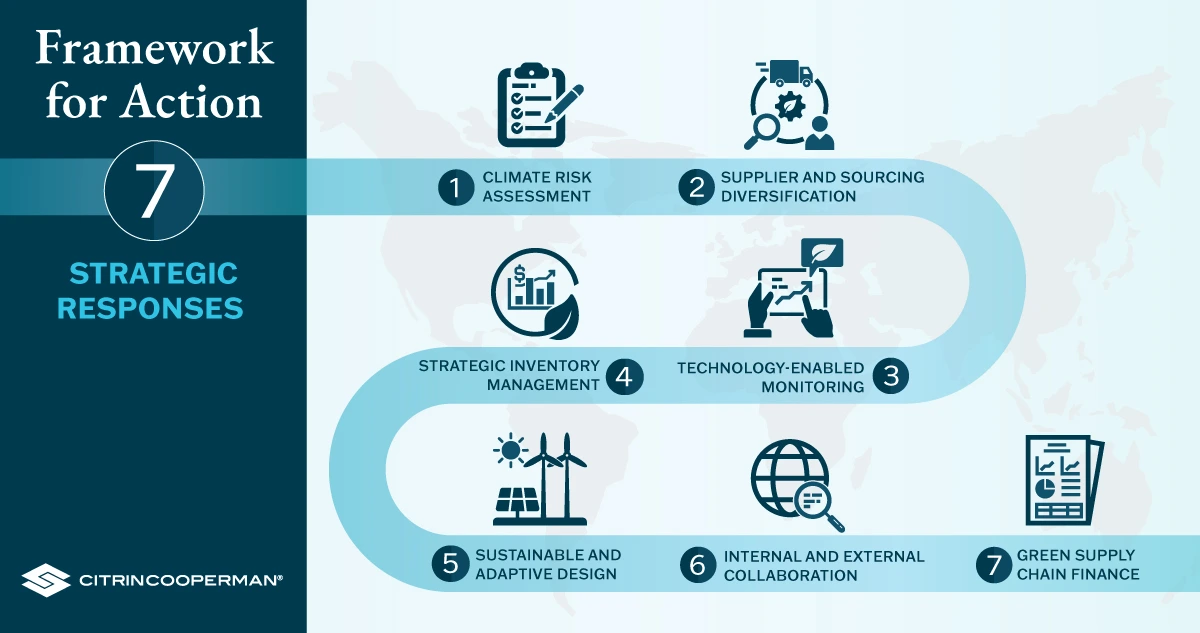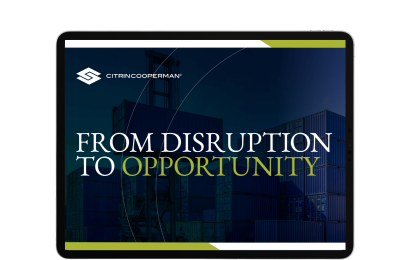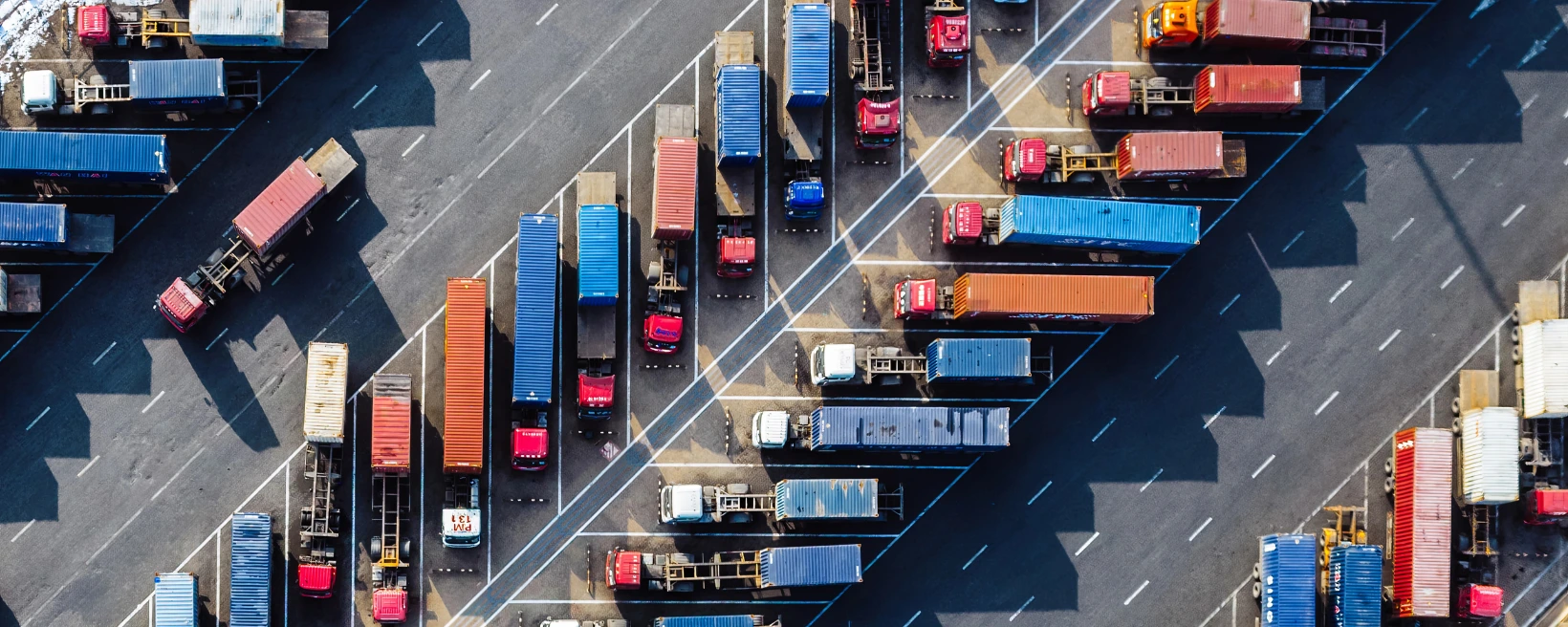The Executive Imperative: Building Resilient Supply Chains Amid Climate Change
Increasingly frequent climate disruptions threaten operational continuity, financial performance, and the reputation of manufacturing and distribution businesses across sectors. Executives are feeling pressure from both regulators and investors to address these threats systematically, making resilience an enterprise-wide priority. With thoughtful planning and responsiveness, leaders can turn challenges in the supply chain into valuable opportunities for growth.
Framework for Action: Strategic Responses
Supply chain resilience is now a source of competitive advantage, not just risk mitigation. Market share and margin protection will come from anticipating and responding to volatility better than your competitors. In today’s market, transparent, collaborative, and decarbonized supply chains will earn loyalty from customers and investors.
The following strategies form the backbone of the responsive actions needed to create value amidst supply chain uncertainties.

-
Climate Risk Assessment
- Map physical, transition, and network risks using geographic information systems (GIS), climate scenario modeling, and supplier surveys.
- Evaluate vulnerabilities across the entire ecosystem, not just direct suppliers, looking for hotspots and bottlenecks.
- Prioritize mitigation plans for production zones, logistics routes, and supply clusters most exposed to disruptions.
-
Supplier and Sourcing Diversification
- Avoid overreliance on high-risk geographies or vendors. Executives are championing dual and multi-sourcing for mission-critical components.
- Expand engagement with suppliers demonstrating climate resilience or adaptation readiness.
- Diversify regionally to help mitigate simultaneous climate threats.
-
Technology-Enabled Monitoring
- Invest in real-time monitoring with enterprise resource planning (ERP)-enabled strategies, supply chain visibility tools, production and fulfillment dashboards, and integrated financial forecasting to anticipate and mitigate disruption.
- Use digital supply chain twins to simulate weather impacts and model contingency plans.
- Integrate social listening tools with planning systems to better forecast demand shifts linked to climate events.
-
Strategic Inventory Management
- Balance efficiency with resilience by building inventory buffers for critical components and relocating stock to safe locations.
- Systematically analyze the tradeoff between lean inventory practices and business continuity in high-risk conditions.
- Increase strategic safety stock in vulnerable markets while maintaining lean approaches elsewhere.
-
Sustainable and Adaptive Design
- Develop products and processes with climate adaptation in mind, including modular components, recyclable materials, and flexible supply chains.
- Shorten supply chains through nearshoring and reshoring to reduce reliance on long and vulnerable routes.
-
Internal and External Collaboration
- Build alliances with non-governmental organizations (NGOs), government agencies, suppliers, and logistics businesses for system-wide risk sharing and adaptation.
- Foster transparent data sharing, align incentives, and jointly develop resilience strategies across the supply network.
-
Green Supply Chain Finance
- Leverage sustainability-focused financing programs to fund climate resilience and decarbonization initiatives.
- Use environment, social, and governance (ESG) metrics and climate risk disclosures to attract investors and meet new compliance expectations.
Focus on Agility with Citrin Cooperman
Climate change has transformed supply chain management into an executive-level challenge and opportunity. Building sustainable supply chains in 2025 demands strategic vision, multi-stakeholder collaboration, a technology-enabled approach to sensing and responding to ongoing volatility, and persistent agility. Forward-looking leaders will move beyond survival, leveraging resilience as a growth engine and a catalyst for transformation across markets. Executives who act decisively today will ensure their businesses remain robust not only against the climate risks of today, but also the uncertainty of tomorrow.
Citrin Cooperman’s Manufacturing and Distribution Industry Practice is prepared d to help your business navigate uncertainty in the supply chain to create future value. For more information, reach out to Christine Mendoza.
Citrin Cooperman’s 2025 Manufacturing and Distribution Pulse Survey Report

Our 2025 Manufacturing and Distribution Pulse Survey Report of 500 industry leaders gathered insights into what is top of mind for the future. The in-depth analysis highlights key trends shaping the sector, including:
- Strategic supply chain and logistics investments
- Accelerated adoption of AI and advanced tech
- Emerging risks, like tariffs, inflation, and rising costs
- Forward-looking growth strategies, such as M&A and facility expansion
Latest Article Cards

Uncharted No More: Fees and Carried Interest in the Independent Sponsor Sector
Read More

Improving Customer Experiences: The Case for Migrating to Azure
Read More

Shades of Grey: Disclosures Under Section 6103(e)(8)
Read More

Cannabis Industry Alert: Executive Order Directs Completion of Marijuana Rescheduling Rulemaking
Read More


